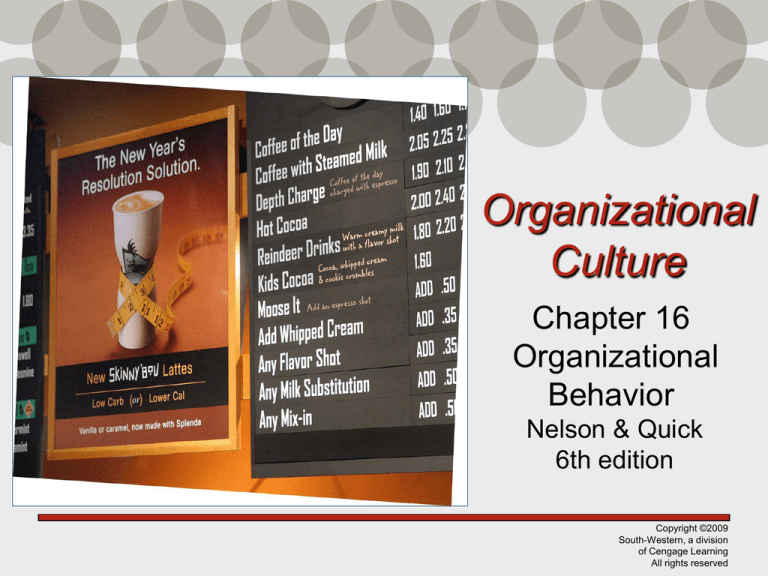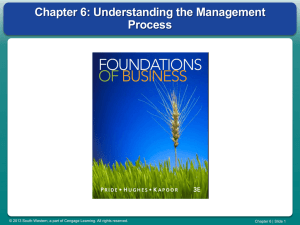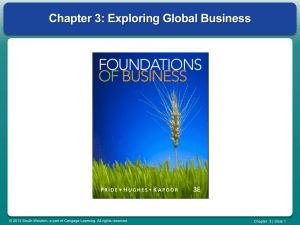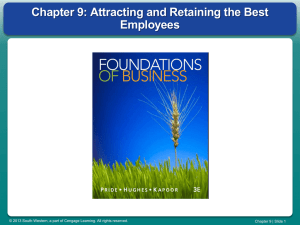
Organizational
Culture
Chapter 16
Organizational
Behavior
Nelson & Quick
6th edition
Copyright ©2009
South-Western, a division
of Cengage Learning
All rights reserved
Organizational (Corporate)
Culture
Organizational (Corporate) Culture -
a pattern of basic assumptions that
are considered valid and that are
taught to new members as
the way to perceive, think, and
feel in the organization
Copyright ©2009
South-Western, a division
of Cengage Learning
All rights reserved
Artifacts - symbols of
culture in the physical
and social work environment
Values
Espoused: what members of
an organization say they value
Enacted: reflected in the way
individuals actually behave
Levels of
Organizational
Culture
Assumptions - deeply held
beliefs that guide behavior and tell
members of an organization how
to perceive and think about things
Copyright ©2009
South-Western, a division
of Cengage Learning
All rights reserved
Artifacts
•Personal enactment
•Ceremonies and rites
•Stories
•Ritual
•Symbols
Values
•Testable in the physical
environment
•Testable only by social consensus
Basic Assumptions
•Relationship to environment
•Nature of reality, time, and space
•Nature of human nature
•Nature of human activity
•Nature of human relationships
Organizational
Culture Levels
Visible, often not
decipherable
Greater level
of awareness
Taken for granted
Invisible Preconscious
Copyright ©2009
Reprinted with permission from Edgar H. Schein,
South-Western, a division
Organizational Culture and Leadership: A Dynamic View.
of Cengage Learning
Copyright © 1985 Jossey-Bass
All rights reserved
Inc, a subsidiary of John Wiley & Sons, Inc.
Functions of Organizational Culture
• Culture provides a sense of identity to
members and increases their
commitment to the organization
• Culture is a sense-making device
for organization members
• Culture reinforces the values
in the organization
• Culture serves as a control
mechanism for shaping
behavior
Copyright ©2009
South-Western, a division
of Cengage Learning
All rights reserved
Theories about the
relationship between
organizational culture
and performance
Adaptive
Perspective
Strong
Culture
Perspective
Fit
Perspective
Copyright ©2009
South-Western, a division
of Cengage Learning
All rights reserved
An organizational culture with a
consensus on the values that
drive the company and with an
intensity that is recognizable
even to outsiders
Strong
Culture
Perspective
Strong cultures facilitate performance because
• They are characterized by goal alignment
• They create a high level of motivation because
of shared values by the members
• They provide control without the oppressive
effects of bureaucracy
Copyright ©2009
South-Western, a division
of Cengage Learning
All rights reserved
Argument that a culture is
good only if it fits the industry’s
or the firm’s strategy.
Fit
Perspective
Organizational characteristics that may affect culture
• Customer requirements
• Competitive environment
• Societal expectations
Useful to explain short term but not long term performance
Indicates the difficulty of changing culture quickly but doesn’t
explain how firms can adapt to environmental change.
Copyright ©2009
South-Western, a division
of Cengage Learning
All rights reserved
An organizational culture that
encourages confidence and
risk taking among employees,
has leadership that produces
change, and focuses on the
changing needs of customers
Core
Values
Adaptive
Perspective
Adaptive
Nonadaptive
Most managers care
about customers,
stockholders, and
employees
Most managers care
about themselves,
their work group, or
an associated product
Managers pay close
Common attention to all
Behavior their constituencies,
esp. customers
Managers tend to
behave somewhat
insularly, politically,
and bureaucratically
Reprinted with the permission of The Free Press, a Division of Simon & Schuster, Inc. from Corporate Culture and Performance by
John P. Kotter and James L Heskett. Copyright © 1992 by Kotter Associates, Inc. and James L. Heskett.
Copyright ©2009
South-Western, a division
of Cengage Learning
All rights reserved
Five Most Important Elements
in Managing Culture
• What leaders pay attention to
• How leaders react to crises
• How leaders behave
• How leaders allocate rewards
• How leaders hire and fire individuals
Copyright ©2009
South-Western, a division
of Cengage Learning
All rights reserved
Organizational Socialization
Organizational socialization - the
process by which newcomers are
transformed from outsiders to
participating, effective members
of the organization
Copyright ©2009
South-Western, a division
of Cengage Learning
All rights reserved
1. Anticipatory
Socialization
2. Encounter
3. Change and
Acquisition
Outcomes of Socialization
Stages of
Socialization
Realism
Congruence
Job demands
•Task
•Role
•Interpersonal
Mastery
Performance
Satisfaction
Mutual influence
Low levels of distress
Intent to remain
From “An Ethical Weather Repart: Assessing the Organization's Ethical Climate” by John B. Cullen, et al. In Organizational Dynamics, Autumn 1989. Copyright ©
1989 American Management Association International. Reprinted by permission of American Management Association International, New York, N.Y. All rights
reserved. Http://www.amanet. Org.
Copyright ©2009
South-Western, a division
of Cengage Learning
All rights reserved
The Three Stages of Socialization
1. Anticipatory Socialization – encompasses
all of the learning that takes place prior to the
newcomer’s first day on the job
2. Encounter - the newcomer learns the tasks
associated with the job, clarifies roles, and
establishes new relationships at work
3. Change & Acquisition - the
newcomer begins to master the
demands of the job
Copyright ©2009
South-Western, a division
of Cengage Learning
All rights reserved
Socialization as
Cultural Communication
Core values are transmitted to new organization
members through
– the role models they interact with
– the training they receive
– the behavior they observe being rewarded
and punished
Copyright ©2009
South-Western, a division
of Cengage Learning
All rights reserved
Assessing Organizational Culture
• Organizational Culture Inventory focuses on
behaviors that help employees fit into the
organization & meet coworker expectations
• Kilman-Saxton Culture-Gap Survey focuses on
the expectations of others in the organization
• Triangulation - the use of multiple methods to
measure organizational culture
Copyright ©2009
South-Western, a division
of Cengage Learning
All rights reserved
Situations That May Require
Cultural Changes
• Merger or acquisition
• Employment of people from different
countries
Reasons That Change Is Difficult
• Assumptions are often unconscious
• Culture is deeply ingrained and
behavioral norms and rewards are well
learned
Copyright ©2009
South-Western, a division
of Cengage Learning
All rights reserved
Hiring and
socializing
members who
fit in with the
new culture
4
3
Culture
Cultural
communication
Interventions for
Changing
Organizational
Culture
Removing
members who
reject the
new culture
Changing
behavior
5
1
Examining
justifications
for changed
behavior
2
Managers seeking to create change must intervene at these points
Reprinted with permission from Vijay Sathe “How to Decipher & Change Corporate Culture,” Copyright ©
1985 Jossey-Bass Inc, Reprinted by permission Of Jossey-Bass, Inc., a subsidiary of John Wiley & Sons, Inc..
Copyright ©2009
South-Western, a division
of Cengage Learning
All rights reserved
Cultural Modifications in the
Current Business Environment
Support for a global
view of business
Reinforcement of
ethical behavior
Empowerment of
employees to excel
in product and
service quality
Photos courtesy of Clips Online, © 2008 Microsoft Corporation
Copyright ©2009
South-Western, a division
of Cengage Learning
All rights reserved
Support for a Global
View of Business
• Create a clear and simple
mission statement
• Create systems that ensure
effective information flow
• Create “matrix minds” among managers
• Develop global career paths
• Use cultural differences as major assets
• Implement worldwide management
education and team development programs
Photos courtesy of Clips Online, © 2008 Microsoft Corporation
Copyright ©2009
South-Western, a division
of Cengage Learning
All rights reserved
Reinforcement of
Ethical Behavior
• Clear communication of the
boundaries of ethical conduct
• Selection of employees who support the
ethical culture
• Reward of ethical behavior
• Conspicuous punishment of members
who engage in unethical behavior
Photos courtesy of Clips Online, © 2008 Microsoft Corporation
Copyright ©2009
South-Western, a division
of Cengage Learning
All rights reserved
Empowerment of Employees
to Excel in Product and
Service Quality
• Empowerment unleashes
employees’ creativity
• Empowerment requires eliminating
traditional hierarchical notions of power
– Involve employees in decision making
– Remove obstacles to their performance
– Communicate the value of product and
service quality
Photos courtesy of Clips Online, © 2008 Microsoft Corporation
Copyright ©2009
South-Western, a division
of Cengage Learning
All rights reserved
Chapter 16: Reflect & Discuss
Backdraft Video Clip
What to Watch for and Ask Yourself
• What parts of the Chicago fire department
culture does this scene show? Does the scene
show any cultural artifacts or symbols? If it does,
what are they?
• Does the scene show any values or norms that
guide the firefighters’ behavior? If it does, what
are they?
• What does Brian McCaffrey learn on his first
workday?
Copyright ©2009
South-Western, a division
of Cengage Learning
All rights reserved





